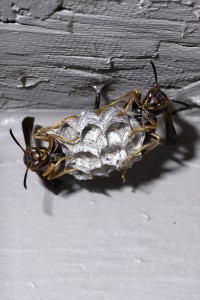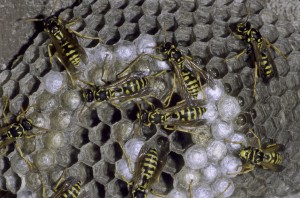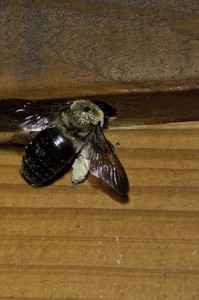Twelve tips to control, exclude and cash in on stinging insect pests for clients.
Most national pest management companies provide stinging insect pest management services throughout the U.S. Some areas of the country — where temperatures typically stay above 50 degrees Fahrenheit — have stinging insect populations year-round. In other areas of the country, especially in the North, stinging insect control often is a seasonal, add-on business. Some companies have found this to be such a profitable niche they’ve built their businesses around such specialized services. Arizona Wings N’ Stings, for example, specializes in bird and stinging insect control. Whether stinging insect pest management is a year-round or seasonal service you provide, following are 12 suggestions to improve your effectiveness and bottom line:
1. Provide quick and efficient service to clients facing stinging insect problems. Most residential and commercial clients view stinging insect problems as emergencies. The most-effective way to earn stinging insect pest management business is by handling these types of inquiries quickly and carefully. Case in point: Eight years ago, we received a phone call from a local board of education about an emergency stinging insect issue at one of its schools. The current pest management firm couldn’t service the school for a few days because the company was too busy. We had a technician on-site within one hour to solve the problem. Now we service all of their schools’ monthly; we perform general insect, termite, nuisance wildlife and rodent control at the sites. The moral of the story: If you treat people right, they’ll remember you and treat you right. Have an emergency service protocol for stinging insects — including night and weekend service. Note: You can charge a premium for providing off-hour services.
2. Remove nests after treatments. We’ve seen instances in which some companies leave the nests behind, which looks like unfinished business. If you were a building contractor, would you leave wood, papers and construction debris on the floor or ground when you were done with your work? Customers view leaving stinging insect nests behind as unprofessional, and customers’ perceptions have a lot to do with what we do or don’t do.
3. Perform exclusion work after treating. Sometimes stinging insects lodge their nests in wall voids inaccessible from the exterior. If your company performs exclusion work, install screening over access areas. Some companies have carpentry/construction divisions, and might recommend installing something more permanent and aesthetically pleasing, such as wooden boards, or repairing or replacing soffits. This can lead to additional revenue. If you don’t perform exclusion work, find a contractor you trust and recommend him.
4. Dress in full protective gear when you perform stinging insect pest management work. Don’t learn the hard way. Too many technicians get stung. In these cases, when asked whether they were wearing their stinging insect protective gear, the typical pest management professional (PMP) replies, “No, it was in the truck.” Have a policy technicians must wear protective gear on all stinging insect jobs, and make it mandatory for all technicians to wear respirators when applying materials.
5. Provide two technicians when using a ladder to control stinging insects. Make this a company policy. Safety is Job No. 1. Don’t use ladders taller than 40 ft. Our policy is to use a bucket truck or an articulating lift for any work higher than 40 ft. It might cost the client more money, but the safety of your staff comes first. On rare occasions, we’ve even used a boatswain’s chair to treat such difficult-to-reach areas.
6. After treatments, warn clients to be careful when going outside for the first 24 hours. Remind them to keep their young children and pets inside. If a client isn’t home, call and email him to take caution. Have technicians write on the service ticket to proceed outside with caution for the first 24 hours. Don’t assume clients will know this. Furthermore, treat for yellowjackets and hornets at night, when the entire colonies typically are in their nests.
7. Take photos of nests in difficult-to-reach areas and show your customers — like in the corner of an attic or near the chimney. Most clients will be fascinated by the photos. Some will even share the photos with family, friends, neighbors and coworkers. This builds value in what you do, and can drive referrals.
8. Perform service for as many types of stinging insect pests as possible in your area. Service can be provided for the control of, among others:
■ carpenter bees;
■ cicada killers;
■ mud daubers;
■ hornets;
■ bald-faced hornets;
■ digger or scoliid wasps;
■ paper wasps;
■ umbrella wasps; and
■ yellowjackets.
Do not treat for honey bees, because they’re beneficial. When we encounter them, we refer our customers to a beekeeper. Last summer, we received a call from one of our larger commercial clients who’s the facilities director for an airport. He said there were honey bees on one of the planes on the tarmac, so they couldn’t fly the plane. The beekeeper we referred solved the problem immediately. We’ve used his services throughout the years at medical facilities, condominiums, townhouses and single-family residences. Don’t just refer anyone to do this work for you, however. Check their references because it’s a reflection of your company. We also have a reciprocal relationship with the beekeeper. He regularly refers us to other stinging insect and general pest control clients.
9. Be flexible with the frequency of service you provide for stinging insect control. Some clients will want just a one-time service. Keep their names in a tickler file and contact them one year later. Others will sign up for quarterly or monthly service. Thoroughly inspecting while you’re on-site can lead to finding other pests, and might convince your client an increased frequency is necessary. Also, offer a preventive stinging insect service as an annual contract. We have a client who is highly allergic to stings and prefers a once-a-year service performed every May.
10. Sell an annual stinging insect renewal program, so clients have unlimited service throughout the year. We have numerous condominiums and townhouses on this program. Some programs have been in place for many years. Warning: Consider all factors and costs when pricing these programs, so you don’t lose money.
11. Offer an annual carpenter-bee contract renewal. It keeps you in front of clients and generates additional revenue.
12. Implement a thorough training program for technicians that covers all of the aforementioned items. The first thing our new technicians must do after orientation is complete a 10-hour Occupational Safety and Health Administration (OSHA) class. We also have technicians fitted and trained for respirators and ladders, and certified for lifts, scaffolds and power tools. PMPs are also trained in-house on our custom designed protocols.
Become the total solution for your clients’ stinging pest management needs. Make your competition irrelevant by providing excellent customer service and first-class workmanship. Teach your staff to have a can-do attitude. The bottom line: Stinging insect pest management is worth all of the extra work.
You can reach the Austs, owners of Paramus, N.J.-based Bug Doctor, at stuart@bugdoctorinc.com.



Leave A Comment